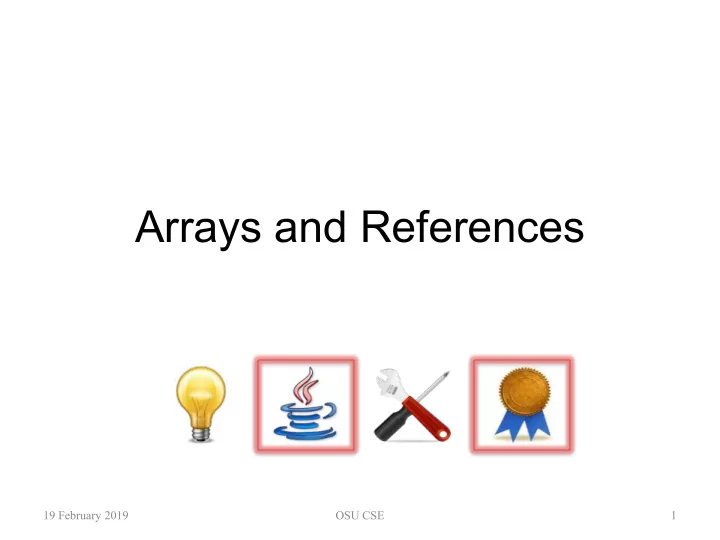

Arrays and References 19 February 2019 OSU CSE 1
The Original (Partial) Story • An array is a group of similar variables, all of the same type, and with systematically related names that involve special syntax using […] • Each array element , e.g., a[0] , a[1] , …, acts like a single variable of the type used in the declaration of array a • The variable named a.length contains the number of array elements 19 February 2019 OSU CSE 2
The Original (Partial) Picture int [] a = { 6, 18, 9, –10 }; 6 18 9 -10 4 19 February 2019 OSU CSE 3
The Full Story • In addition, you need to know: – Arrays are reference types – The name of the array (e.g., a in the example) is a reference to the entire collection of element variables a[0] , a[1] , …, and a.length 19 February 2019 OSU CSE 4
The Full Picture int [] a = { 6, 18, 9, –10 }; 6 18 9 -10 4 19 February 2019 OSU CSE 5
Arrays Are Reference Types • You should now be able to predict what happens when you do the following: – Assign one array to another using = – Pass an array as a parameter to a method – Return an array from a method – Compare two arrays for equality with == – But... what does equals do? 19 February 2019 OSU CSE 6
One of the Many Warts of Java • The equals method for arrays does arguably the wrong thing: it compares reference values just like == – You might expect it would compare arrays “element-wise”, and the lengths of the arrays, but it does not – Fortunately, SpotBugs flags the use of equals and explains it is equivalent to == 19 February 2019 OSU CSE 7
What Can Be Done? • You can try to write your own code to check whether two arrays are element- wise equal (but this is surprisingly hard to get right!) • You can use code from the Java libraries in the package java.util – See the class Arrays – Use the static method Arrays.deepEquals 19 February 2019 OSU CSE 8
What Can Be Done? This is the handiest package in • You can try to write your own code to the Java libraries for general- check whether two arrays are element- purpose use; you should know about it. wise equal (but this is surprisingly hard to get right!) • You can use code from the Java libraries in the package java.util – See the class Arrays – Use the static method Arrays.deepEquals 19 February 2019 OSU CSE 9
Best Practices for Arrays • Avoid them in industrial-strength software – OK in exercises intended to demonstrate the basics of arrays (because there is so much Java code “in the wild” that uses arrays), and in simple throw-away programs • Recommended alternatives: – Java libraries: java.util.List interface with ArrayList implementation – OSU CSE components: Array , Sequence 19 February 2019 OSU CSE 10
Resources • Java Tutorials – http://docs.oracle.com/javase/tutorial/java/nutsandbolts/arrays.html • Java for Everyone , Section 6.1 – http://proquest.safaribooksonline.com.proxy.lib.ohio-state.edu/book/- /9781118063316/chapter-6-arrays-and-array-lists/250 • Java Libraries API: Arrays – http://docs.oracle.com/javase/8/docs/api/ • Effective Java , Item 25 – http://proquest.safaribooksonline.com.proxy.lib.ohio- state.edu/book/programming/java/9780137150021/chapter-5- generics/ch05 19 February 2019 OSU CSE 11
Recommend
More recommend